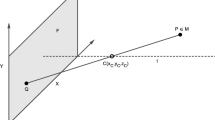Abstract
The reconstruction of 3D objects from photographs is well-known and several methods are implemented in various software. The vast majority of reconstruction software uses statistical methods and rather less geometric knowledge. At hand of an example, we shall illustrate that the reconstruction of a 3D object from a single edgy photo can be done with a small portion of geometric knowledge about conics. We first collect the basic facts about central projections, perspective images, and their rectification. Subsequently, we use some basic properties of conics in order to rectify an image and to reconstruct an object without previously undistorting or deskewing the image itself. The constructive approach is preferred because of its simplicity and shall also be understood as a plea for Descriptive Geometry and Constructive Geometry.
Access this chapter
Tax calculation will be finalised at checkout
Purchases are for personal use only
Similar content being viewed by others
Notes
- 1.
This ambiguity occurs only in English texts. In German, Verschwindungspunkte are those who are mapped to infinity, while Fluchtpunkte are the images of ideal points.
In connection with (perspective) collineations, the image and pre-image of ideal points interchange their meaning if we change from the collineation to its inverse.
- 2.
Here, the German language tends to wipe away the differences between projection and image. Both, the map** and the image are frequently called Perspektive.
References
Brauner, H., Kickinger, W.: Baugeometrie II. Bauverlag GmbH, Wiesbaden - Berlin (1982)
Brauner, H.: Lehrbuch der konstruktiven Geometrie. Springer, Wien (1986)
Glaeser, G., Stachel, H., Odehnal, B.: The Universe of Conics. From the Ancient Greeks to 21\(^{\rm st}\) century developments. Springer, Heidelberg (2016). https://doi.org/10.1007/978-3-662-45450-3
Hartley, R.I.: Theory and practice of projective rectification. Int. J. Comput. Vision 35(2), 1–16 (1999)
Hartley, R.I., Zisserman, A.: Multiple View Geometry in Computer Vision. Cambridge University Press, Cambridge (2003)
Gutruf, G., Stachel, H.: The hidden geometry in Vermeer’s “The Art of Painting.” J. Geom. Graph. 14(2), 187–201 (2010)
Hohenberg, F.H.: Konstruktive Geometrie in der Technik, 3rd edn. Springer, Wien (1966). https://doi.org/10.1007/978-3-7091-8148-5
Paul Neagu. http://www.paulneaguhyphen.com/paul-neagu-sculptor-painter-graphic-artist-poet-1938-2004/paul-neagu-art/
Odehnal, B.: Central projections and distances. KoG 18, 28–35 (2014)
Odehnal, B., Stachel, H., Glaeser, G.: Quadrics and differential geometry. In: Odehnal, B., Stachel, H., Glaeser, G. (eds.) The Universe of Quadrics, pp. 383–474. Springer, Heidelberg (2020). https://doi.org/10.1007/978-3-662-61053-4_9
Szeliski, R.: Motion estimation. In: Szeliski, R. (ed.) Computer Vision. TCS, pp. 443–482. Springer, Cham (2022). https://doi.org/10.1007/978-3-030-34372-9_9
Stachel, H.: What is descriptive geometry for? In: DSG-CK Dresden Symposium Geometrie: konstruktiv & kinematisch, 27 February–1 March 2003, Dresden/Germany, pp. 327-336. TU Dresden (2003). ISBN 3-86005-394-9
Stachel, H.: Descriptive geometry meets computer vision - the geometry of two images. J. Geom. Graph. 10(2), 137–153 (2006)
Stachel, H.: The geometry behind the numerical reconstruction of two photos. In: Proceedings of ICEGD 2007, 2nd International Conference on Engineering Graphics and Design, 7–10 June 2007, Galati/Romania, pp. 193–196 (2007). ISBN 978-973-667-252-1
Szabó, J., Stachel, H., Vogel, H.: A theorem on central axonometry. (Ein Satz über die Zentralaxonometrie.) (German) Sitzungsber., Abt. II, Österr. Akad. Wiss., math.-naturwiss. Kl. 203, 3–11 (2004)
Wunderlich, W.: Darstellende Geometrie II. Bibliographisches Institut, Zürich (1967)
Acknowledgements
The authors are greatful to Toni Neagu for his permission to use the photograph of the installation.
Author information
Authors and Affiliations
Corresponding author
Editor information
Editors and Affiliations
Rights and permissions
Copyright information
© 2023 The Author(s), under exclusive license to Springer Nature Switzerland AG
About this paper
Cite this paper
Odehnal, B., Porsch, J. (2023). Rectification of an Edgy Photograph. In: Cheng, LY. (eds) ICGG 2022 - Proceedings of the 20th International Conference on Geometry and Graphics. ICGG 2022. Lecture Notes on Data Engineering and Communications Technologies, vol 146. Springer, Cham. https://doi.org/10.1007/978-3-031-13588-0_22
Download citation
DOI: https://doi.org/10.1007/978-3-031-13588-0_22
Published:
Publisher Name: Springer, Cham
Print ISBN: 978-3-031-13587-3
Online ISBN: 978-3-031-13588-0
eBook Packages: EngineeringEngineering (R0)




